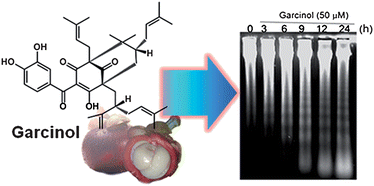Garcinol inhibits cell growth in hepatocellular carcinoma Hep3Bcells through induction of ROS-dependent apoptosis
Abstract

* Corresponding authors
a
Department of Nutrition and Health Sciences, Chang Jung Christian University, Tainan, Taiwan
E-mail:
anniecheng@mail.cjcu.edu.tw
Tel: (+886)-6-278-5926 Ext 3307
b
Department of Seafood Science, National Kaohsiung Marine University, No.142, Haijhuan Rd., Nanzih District, Kaohsiung, Taiwan
E-mail:
mhpan@mail.nkmu.edu.tw
Fax: (+886)-7-361-1261
Tel: (+886)-7-361-7141 Ext 3623
c Sabinsa Corporation, East Windsor, NJ, USA
d Department of Food Science, Rutgers University, New Brunswick, NJ, USA

 Please wait while we load your content...
Something went wrong. Try again?
Please wait while we load your content...
Something went wrong. Try again?
A. Cheng, M. Tsai, C. Liu, M. Lee, K. Nagabhushanam, C. Ho and M. Pan, Food Funct., 2010, 1, 301 DOI: 10.1039/C0FO00134A
To request permission to reproduce material from this article, please go to the Copyright Clearance Center request page.
If you are an author contributing to an RSC publication, you do not need to request permission provided correct acknowledgement is given.
If you are the author of this article, you do not need to request permission to reproduce figures and diagrams provided correct acknowledgement is given. If you want to reproduce the whole article in a third-party publication (excluding your thesis/dissertation for which permission is not required) please go to the Copyright Clearance Center request page.
Read more about how to correctly acknowledge RSC content.
 Fetching data from CrossRef.
Fetching data from CrossRef.
This may take some time to load.
Loading related content
